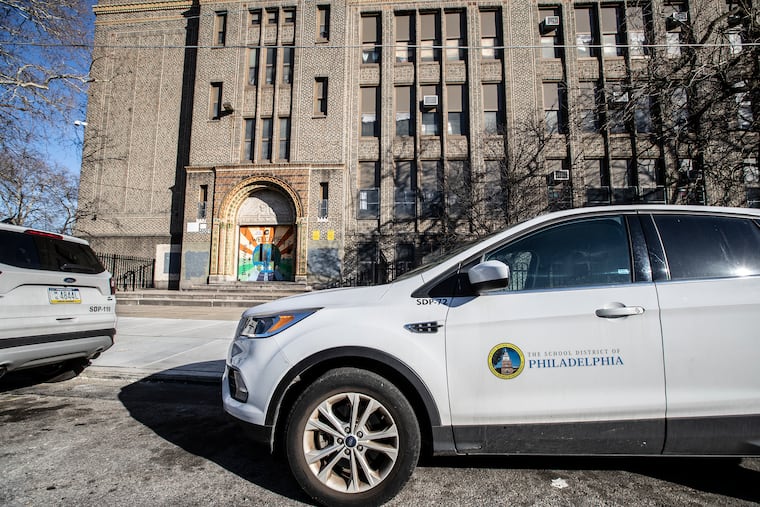Did workers spread asbestos at a Philly school? The district is investigating.
Hopkinson Elementary will remain closed for a third day while the district conducts air sampling to test for asbestos fibers. Union leaders learned Friday of potential contamination during a ceiling tile replacement job over the summer.

The Philadelphia School District is investigating whether workers spread asbestos when replacing ceiling tiles last summer at Hopkinson Elementary, which will remain closed at least until Thursday while the district continues testing air throughout the building, officials said Tuesday.
“We realize that the issue of the work completed this summer is a serious matter that needs investigation by the district,” Superintendent William R. Hite Jr. wrote in a letter to the Juniata school’s parents and staff. “Please know that the protocol that allowed such activity to occur has been changed. Environmental conditions above any ceiling tiles will now be fully assessed before any tile replacement work begins.”
The district agreed Sunday night to close Hopkinson, a crowded K-8 school with 850 students, after the Philadelphia Federation of Teachers (PFT) learned Friday afternoon that a district-hired contractor had replaced ceiling tiles in every classroom and hallway throughout the three-story building, completed in 1927.
PFT leaders said they were upset because a district inspection, conducted over two days in late January, revealed 55 areas of damaged asbestos, including more than two dozen of cracked or fraying pipe insulation above the ceiling, with some debris found on top of the new ceiling tiles. It is unclear whether the insulation was damaged when workers dismantled the old tiles over the summer.
The disclosure raised questions about whether the district replaced tiles without taking necessary precautions at other schools with asbestos-insulated pipes above drop ceilings. In September 2018, school board members authorized the district to spend as much as $300,000 to buy new ceiling tiles from Kamco Building Supplies for replacement jobs at schools through September 2020, records show.
“We need to immediately know what other schools were impacted so we can tell the staff and parents, because people may have been exposed to asbestos,” PFT environmental scientist Jerry Roseman said Tuesday.
The district has yet to answer The Inquirer’s questions, posed Monday, about whether the South Jersey-based contractor, Window Repairs & Restoration, did similar work at other schools.
>> READ THE AWARD-WINNING SERIES: Toxic City: Sick Schools
“We are still reviewing the work that was conducted over the summer so as to better understand what happened and how we move forward, so we’re still gathering some of this information," district spokesperson Megan Lello wrote in an email Monday night. “The contractor confirmed that each room that was to have ceiling tile replaced was emptied of furniture. Anything left behind that could not be moved, including some bookcases, ventilators, etc., was covered with plastic. The floor was also covered with plastic and the edges were taped down.”
Raymond DePiano, owner of Window Repairs & Restoration, did not return calls seeking to know if workers were aware of the asbestos and whether they took precautions to protect themselves and avoid spreading any asbestos fibers.
Under federal regulations, the district must thoroughly inspect schools for asbestos every three years, noting the location of the insulation and whether it has been damaged, which can release disease-causing fibers into the air. The district’s environmental staff must provide a full picture of potential asbestos hazards to contractors before any work is done.
Questions over the protocol for replacing ceiling tiles at Hopkinson echoes missteps made during renovations at Benjamin Franklin High and Science Leadership Academy last fall, when the district’s environmental team failed to flag asbestos inside air ducts and unsuspecting workers took apart the ducts, spreading dust and debris.
On Monday, the district directed asbestos experts with two firms, Vertex Environmental Services and Criterion Laboratories, to immediately begin taking air samples at Hopkinson. Those samples will be analyzed using a sophisticated microscope that can detect the tiniest fibers, Lello said.
Roseman, however, said the sampling method is inadequate because testers are using box fans to stir the air. To truly simulate student and teacher activity, testers would need to use a leaf blower, but that can’t be done safely without potentially disturbing already damaged asbestos, he said. Union leaders have pledged to fight to keep the building closed, regardless of the test results, until the dozens of damaged areas are fixed.
“I think buildings like Hopkinson, which have multiple areas of damaged asbestos materials that are accessible to students and staff in high-contact, high-traffic areas, cannot be considered safe by anyone,” Roseman said. “You can’t put people back into a building with damaged asbestos like this, so why would you air-sample before fixing anything, and then put people back in and leave all the damaged asbestos behind?”
In his letter to Hopkinson parents and staff on Sunday night, Hite said the district moved quickly to protect staff and students after discovering “several imminent hazards related to damaged asbestos-containing materials at the school, including Room S1, the cafeteria, and the counselor’s office." Hite said those areas were immediately closed off.
» READ MORE: READ MORE: Find out how safe your school is
District officials said they hope to reopen Hopkinson “once test results clear the school for re-occupancy,” but students and staff will be temporarily relocated beginning Wednesday. The school’s kindergarten through second graders will remain at Hopkinson’s Little Schoolhouse, a newer annex; third through fifth graders will go to Clemente Middle School, and sixth through eighth graders will learn at Grover Washington Middle School. Relocated students will be bused from Hopkinson.
Hopkinson is the seventh school the district has been forced to close this school year because of concerns about asbestos. Those concerns peaked in early September after longtime teacher Lea DiRusso, who taught for nearly 30 years at Nebinger and Meredith Elementary Schools in South Philadelphia, was diagnosed with mesothelioma, a rare and deadly cancer caused by asbestos. Elementary teachers are at elevated risk for developing mesothelioma, studies show.